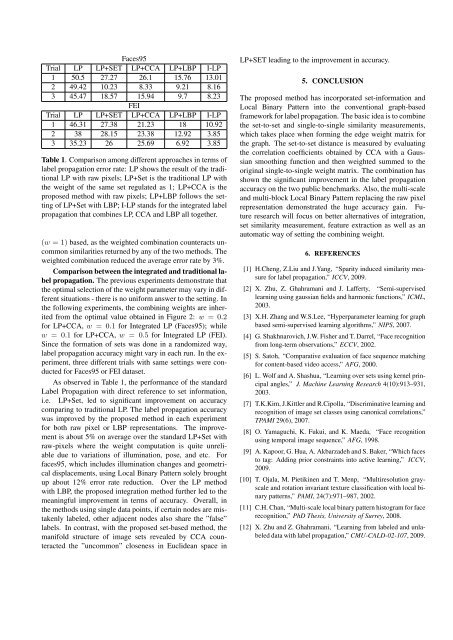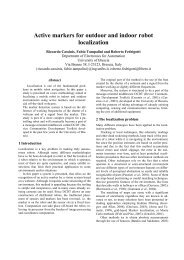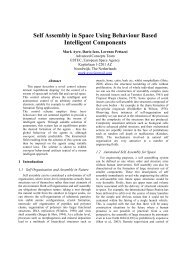SET-BASED LABEL PROPAGATION OF FACE IMAGES Chao Xiong ...
SET-BASED LABEL PROPAGATION OF FACE IMAGES Chao Xiong ...
SET-BASED LABEL PROPAGATION OF FACE IMAGES Chao Xiong ...
You also want an ePaper? Increase the reach of your titles
YUMPU automatically turns print PDFs into web optimized ePapers that Google loves.
Faces95<br />
Trial LP LP+<strong>SET</strong> LP+CCA LP+LBP I-LP<br />
1 50.5 27.27 26.1 15.76 13.01<br />
2 49.42 10.23 8.33 9.21 8.16<br />
3 45.47 18.57 15.94 9.7 8.23<br />
FEI<br />
Trial LP LP+<strong>SET</strong> LP+CCA LP+LBP I-LP<br />
1 46.31 27.38 21.23 18 10.92<br />
2 38 28.15 23.38 12.92 3.85<br />
3 35.23 26 25.69 6.92 3.85<br />
Table 1. Comparison among different approaches in terms of<br />
label propagation error rate: LP shows the result of the traditional<br />
LP with raw pixels; LP+Set is the traditional LP with<br />
the weight of the same set regulated as 1; LP+CCA is the<br />
proposed method with raw pixels; LP+LBP follows the setting<br />
of LP+Set with LBP; I-LP stands for the integrated label<br />
propagation that combines LP, CCA and LBP all together.<br />
(w = 1) based, as the weighted combination counteracts uncommon<br />
similarities returned by any of the two methods. The<br />
weighted combination reduced the average error rate by 3%.<br />
Comparison between the integrated and traditional label<br />
propagation. The previous experiments demonstrate that<br />
the optimal selection of the weight parameter may vary in different<br />
situations - there is no uniform answer to the setting. In<br />
the following experiments, the combining weights are inherited<br />
from the optimal value obtained in Figure 2: w = 0.2<br />
for LP+CCA, w = 0.1 for Integrated LP (Faces95); while<br />
w = 0.1 for LP+CCA, w = 0.5 for Integrated LP (FEI).<br />
Since the formation of sets was done in a randomized way,<br />
label propagation accuracy might vary in each run. In the experiment,<br />
three different trials with same settings were conducted<br />
for Faces95 or FEI dataset.<br />
As observed in Table 1, the performance of the standard<br />
Label Propagation with direct reference to set information,<br />
i.e. LP+Set, led to significant improvement on accuracy<br />
comparing to traditional LP. The label propagation accuracy<br />
was improved by the proposed method in each experiment<br />
for both raw pixel or LBP representations. The improvement<br />
is about 5% on average over the standard LP+Set with<br />
raw-pixels where the weight computation is quite unreliable<br />
due to variations of illumination, pose, and etc. For<br />
faces95, which includes illumination changes and geometrical<br />
displacements, using Local Binary Pattern solely brought<br />
up about 12% error rate reduction. Over the LP method<br />
with LBP, the proposed integration method further led to the<br />
meaningful improvement in terms of accuracy. Overall, in<br />
the methods using single data points, if certain nodes are mistakenly<br />
labeled, other adjacent nodes also share the ”false”<br />
labels. In contrast, with the proposed set-based method, the<br />
manifold structure of image sets revealed by CCA counteracted<br />
the ”uncommon” closeness in Euclidean space in<br />
LP+<strong>SET</strong> leading to the improvement in accuracy.<br />
5. CONCLUSION<br />
The proposed method has incorporated set-information and<br />
Local Binary Pattern into the conventional graph-based<br />
framework for label propagation. The basic idea is to combine<br />
the set-to-set and single-to-single similarity measurements,<br />
which takes place when forming the edge weight matrix for<br />
the graph. The set-to-set distance is measured by evaluating<br />
the correlation coefficients obtained by CCA with a Gaussian<br />
smoothing function and then weighted summed to the<br />
original single-to-single weight matrix. The combination has<br />
shown the significant improvement in the label propagation<br />
accuracy on the two public benchmarks. Also, the multi-scale<br />
and multi-block Local Binary Pattern replacing the raw pixel<br />
representation demonstrated the huge accuracy gain. Future<br />
research will focus on better alternatives of integration,<br />
set similarity measurement, feature extraction as well as an<br />
automatic way of setting the combining weight.<br />
6. REFERENCES<br />
[1] H.Cheng, Z.Liu and J.Yang, “Sparity induced similarity measure<br />
for label propagation,” ICCV, 2009.<br />
[2] X. Zhu, Z. Ghahramani and J. Lafferty, “Semi-supervised<br />
learning using gaussian fields and harmonic functions,” ICML,<br />
2003.<br />
[3] X.H. Zhang and W.S.Lee, “Hyperparameter learning for graph<br />
based semi-supervised learning algorithms,” NIPS, 2007.<br />
[4] G. Shakhnarovich, J.W. Fisher and T. Darrel, “Face recognition<br />
from long-term observations,” ECCV, 2002.<br />
[5] S. Satoh, “Comparative evaluation of face sequence matching<br />
for content-based video access,” AFG, 2000.<br />
[6] L. Wolf and A. Shashua, “Learning over sets using kernel principal<br />
angles,” J. Machine Learning Research 4(10):913–931,<br />
2003.<br />
[7] T.K.Kim, J.Kittler and R.Cipolla, “Discriminative learning and<br />
recognition of image set classes using canonical correlations,”<br />
TPAMI 29(6), 2007.<br />
[8] O. Yamaguchi, K. Fukui, and K. Maeda, “Face recognition<br />
using temporal image sequence,” AFG, 1998.<br />
[9] A. Kapoor, G. Hua, A. Akbarzadeh and S. Baker, “Which faces<br />
to tag: Adding prior constraints into active learning,” ICCV,<br />
2009.<br />
[10] T. Ojala, M. Pietikinen and T. Menp, “Multiresolution grayscale<br />
and rotation invariant texture classification with local binary<br />
patterns,” PAMI, 24(7):971–987, 2002.<br />
[11] C.H. Chan, “Multi-scale local binary pattern histogram for face<br />
recognition,” PhD Thesis, University of Surrey, 2008.<br />
[12] X. Zhu and Z. Ghahramani, “Learning from labeled and unlabeled<br />
data with label propagation,” CMU-CALD-02-107, 2009.




